Mini unveiled more than just their Electric Concept at the Frankfurt Auto Show this year, showcasing the John Cooper Works GP Concept, a model that strongly hints at a production-ready future. This concept embodies the pure essence of Mini’s driving pleasure, representing “maximum performance, maximum Mini,” as described by BMW Group design head Adrian van Hooydonk. It’s clear Mini is targeting enthusiasts who appreciate weekend track days and demand unadulterated driving thrills.
 Front view of the Mini John Cooper Works GP Concept showcasing its aggressive air intakes and sporty design
Front view of the Mini John Cooper Works GP Concept showcasing its aggressive air intakes and sporty design
The design of the John Cooper Works GP Concept is immediately striking, packed with scoops and vents that scream performance. These aren’t just for show; they’re designed to maximize airflow, essential for cooling a high-performance machine built for fun. The side air intakes are particularly reminiscent of iconic mid-engined rally hatchbacks like the Metro 6R4 and Renault Turbo 2, adding a touch of motorsport pedigree to its visual appeal, even though the Mini GP remains front-engined.
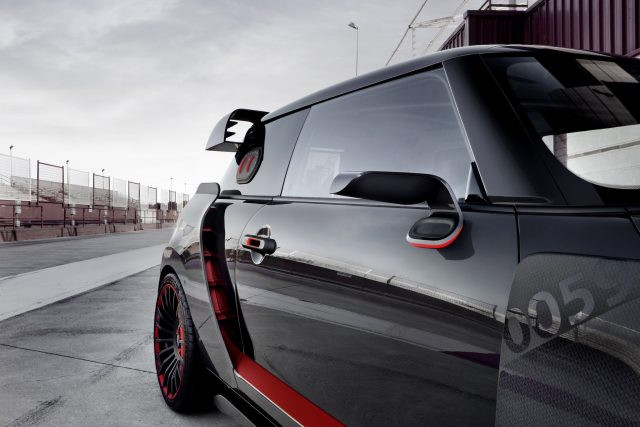 Side profile of the Mini John Cooper Works GP Concept highlighting the side air intakes
Side profile of the Mini John Cooper Works GP Concept highlighting the side air intakes
The concept is adorned with scoops and vents at every turn, emphasizing its performance-oriented nature. Every design element seems geared towards optimizing airflow and enhancing the driving experience. This aggressive styling leaves no doubt about the vehicle’s intentions – pure driving exhilaration.
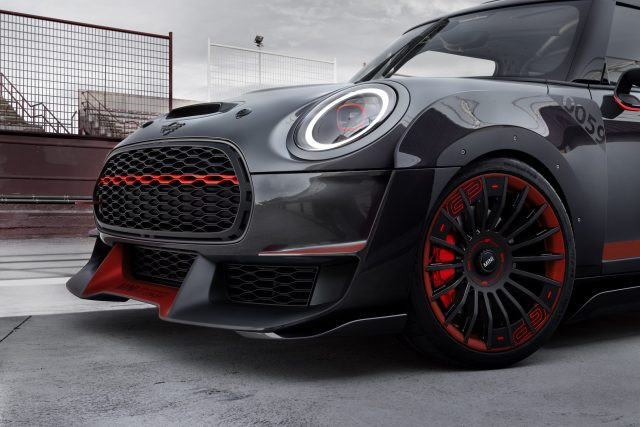 Close-up of the front scoops and vents of the Mini John Cooper Works GP Concept emphasizing airflow maximization
Close-up of the front scoops and vents of the Mini John Cooper Works GP Concept emphasizing airflow maximization
The rear of the concept hints at distinctive Union Jack LED tail lights, a feature that has become a modern Mini signature. These lights not only add a unique visual element but also subtly nod to Mini’s British heritage.
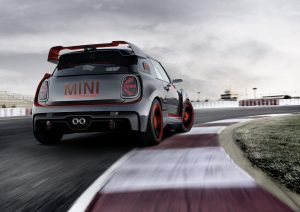 Rear detail of the Mini John Cooper Works GP Concept featuring Union Jack LED tail lights
Rear detail of the Mini John Cooper Works GP Concept featuring Union Jack LED tail lights
Inside, the John Cooper Works GP Concept is stripped down and focused. The interior emphasizes functionality and weight reduction, key elements for a track-focused vehicle. This pared-back approach signals a commitment to driving purity and performance.
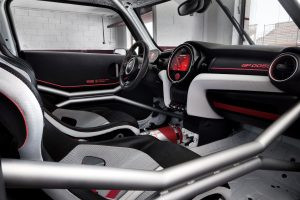 Minimalist interior of the Mini John Cooper Works GP Concept emphasizing its track-focused design
Minimalist interior of the Mini John Cooper Works GP Concept emphasizing its track-focused design
A roll cage is prominently featured, further reinforcing the concept’s track intentions. While the robustness of this specific design is debatable for production, it underscores the performance focus. It’s unlikely this exact roll cage will make it to the road version, but it sets the performance tone.
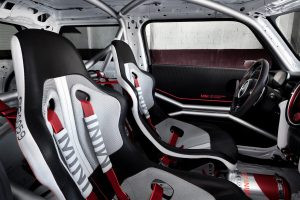 Roll cage detail inside the Mini John Cooper Works GP Concept highlighting its track-ready features
Roll cage detail inside the Mini John Cooper Works GP Concept highlighting its track-ready features
Similarly, the camera-based side mirrors are likely concept-only features. Traditional mirrors are expected for the production model, adhering to road regulations and practicality.
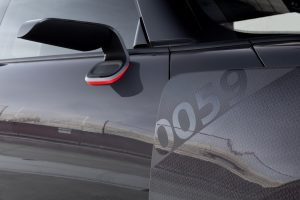 Camera-based side mirror detail on the Mini John Cooper Works GP Concept representing concept car technology
Camera-based side mirror detail on the Mini John Cooper Works GP Concept representing concept car technology
True to its predecessors, the John Cooper Works GP Concept strongly suggests the road car version will ditch the rear seats. Weight reduction is paramount in achieving peak performance, and eliminating rear seats is a straightforward way to enhance agility and speed.
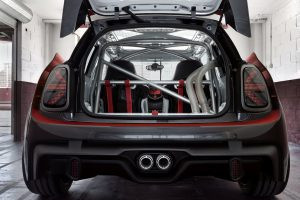 Absence of rear seats in the Mini John Cooper Works GP Concept indicating its focus on performance and weight reduction
Absence of rear seats in the Mini John Cooper Works GP Concept indicating its focus on performance and weight reduction
The exaggerated front scoop design might appear comically large, but it emphasizes the focus on maximizing air intake for performance. This bold design choice is a testament to the extreme nature of the GP Concept, prioritizing function and aggressive aesthetics.
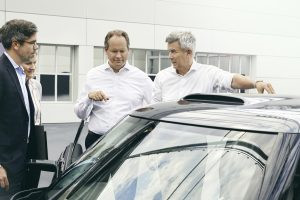 Oversized front scoop detail of the Mini John Cooper Works GP Concept emphasizing aggressive styling and air intake
Oversized front scoop detail of the Mini John Cooper Works GP Concept emphasizing aggressive styling and air intake
The Legacy of John Cooper
To truly appreciate the John Cooper Works GP, it’s essential to understand the significance of John Cooper himself. While Alec Issigonis designed the original Mini, John Cooper’s engineering genius elevated it into a motorsport icon. Cooper, a successful racing car builder in the 1950s, understood the advantages of smaller, lighter, mid-engined cars in racing, challenging larger, more powerful competitors in Formula 1 and at Indianapolis. When BMC sought to inject racing DNA into the Mini, they naturally turned to Cooper.
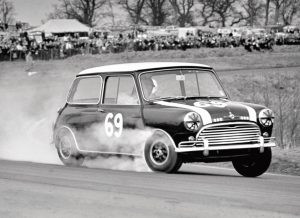 Historical image of a Mini Cooper racing car at Oulton Park in 1965 showcasing its racing heritage
Historical image of a Mini Cooper racing car at Oulton Park in 1965 showcasing its racing heritage
The collaboration was immensely successful. Cooper-tuned Minis achieved victories in prestigious events like the Monte Carlo Rally and various touring car races. These nimble Minis often outperformed much larger and seemingly more powerful cars, proving that agility and clever engineering could triumph over brute force. This racing success translated directly to showroom appeal, making the Mini Cooper the must-have version for driving enthusiasts.
GP Heritage: Performance in its DNA
The John Cooper Works GP Concept is not the first of its kind. Mini has a history of producing GP models, each representing the pinnacle of performance within the Mini range. Previous iterations have also prioritized weight reduction and track-focused enhancements.
 Image of the previous generation John Cooper Works GP highlighting its lineage of performance-focused models
Image of the previous generation John Cooper Works GP highlighting its lineage of performance-focused models
The previous generation John Cooper Works GP also famously lacked rear seats, a tradition continued by this new concept, underscoring the unwavering commitment to ultimate performance. This lineage reinforces the GP badge as a symbol of Mini’s most extreme and thrilling driving experiences.
 Image showcasing the absence of rear seats in the previous generation John Cooper Works GP, a signature feature of GP models
Image showcasing the absence of rear seats in the previous generation John Cooper Works GP, a signature feature of GP models
Mini’s recent successes in racing further fuel anticipation for the new GP road car. With a strong motorsport foundation and a dedication to driving fun, the John Cooper Works GP is poised to be an exhilarating track weapon and a worthy successor to its performance heritage.
